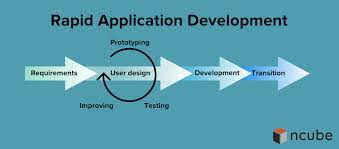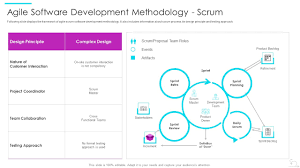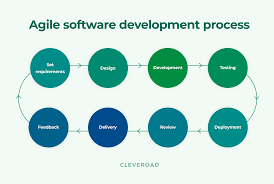Accelerating Innovation: The Power of Rapid Software Development
The Advantages of Rapid Software Development
Rapid software development is a methodology that focuses on quickly creating high-quality software through iterative processes and collaboration. This approach has gained popularity in recent years due to its efficiency and effectiveness in meeting the ever-changing demands of the market.
Benefits of Rapid Software Development:
Faster Time-to-Market:
One of the key advantages of rapid software development is its ability to deliver products to market quickly. By breaking down the development process into smaller, manageable chunks, teams can release functional software incrementally, allowing for faster feedback and adaptation to changes.
Flexibility and Adaptability:
Rapid software development allows for greater flexibility in responding to changing requirements or customer feedback. Teams can easily incorporate new features or make adjustments during the development process, ensuring that the final product meets stakeholders’ needs effectively.
Improved Collaboration:
Collaboration is at the core of rapid software development. By involving all stakeholders, including developers, designers, and end-users, in the development process from the beginning, teams can ensure that everyone’s input is considered and incorporated. This leads to a more cohesive and user-friendly end product.
Reduced Costs:
Due to its iterative nature, rapid software development can help reduce costs associated with rework or late-stage changes. By catching issues early on and continuously testing and refining the software throughout the process, teams can avoid costly delays and ensure a more efficient use of resources.
Conclusion:
Rapid software development offers numerous benefits for organizations looking to stay competitive in today’s fast-paced market. By prioritizing speed, flexibility, collaboration, and cost-effectiveness, teams can deliver high-quality software that meets user needs effectively while adapting to changing requirements swiftly.
Understanding Rapid Software Development: Key FAQs and Insights
- What is rapid software development?
- How does rapid software development differ from traditional methods?
- What are the benefits of using rapid software development?
- What are the challenges associated with rapid software development?
- How can teams ensure quality while using rapid software development?
- What tools and technologies are commonly used in rapid software development?
- How does customer feedback play a role in rapid software development?
What is rapid software development?
Rapid software development is a methodology that emphasizes quick and iterative approaches to creating software solutions. It involves breaking down the development process into smaller, manageable increments to deliver functional products faster. This approach focuses on flexibility, adaptability, and collaboration among team members and stakeholders to ensure that the software meets evolving requirements efficiently. By prioritizing speed and responsiveness to changes, rapid software development aims to streamline the development process, reduce costs, and improve time-to-market for software products.
How does rapid software development differ from traditional methods?
In the realm of software development, the key distinction between rapid software development and traditional methods lies in their approach to the development process. Rapid software development emphasizes iterative and incremental cycles, focusing on delivering functional software quickly and continuously incorporating feedback from stakeholders. This agile approach allows for greater flexibility, adaptability, and collaboration throughout the development lifecycle. In contrast, traditional methods often follow a more linear and sequential process, with a heavy emphasis on upfront planning and documentation. While traditional methods may provide a structured framework for development, rapid software development offers a more dynamic and responsive way to address evolving requirements and deliver value to end-users in a timely manner.
What are the benefits of using rapid software development?
When considering the benefits of using rapid software development, several advantages stand out. Firstly, the methodology allows for faster time-to-market, enabling teams to release functional software incrementally and gather feedback early on for quick adjustments. Additionally, rapid software development offers flexibility and adaptability, allowing teams to respond promptly to changing requirements or customer feedback throughout the development process. Improved collaboration is another key benefit, as involving all stakeholders from the beginning ensures that everyone’s input is considered and integrated effectively. Moreover, the iterative nature of rapid software development helps reduce costs by identifying and addressing issues early on, ultimately leading to more efficient resource utilization.
What are the challenges associated with rapid software development?
When it comes to rapid software development, several challenges need to be addressed. One common challenge is maintaining quality while working under tight timelines. The pressure to deliver quickly can sometimes lead to overlooking crucial aspects such as thorough testing and code review, which may result in bugs and issues in the final product. Another challenge is managing changing requirements effectively. In a fast-paced environment, requirements can evolve rapidly, making it essential for teams to have robust communication and prioritization processes in place to ensure that the software meets stakeholders’ needs. Additionally, coordinating collaboration among team members and stakeholders can be challenging, especially when working on quick iterations. Overcoming these challenges requires a well-structured development process, clear communication channels, and a focus on balancing speed with quality to achieve successful outcomes in rapid software development projects.
How can teams ensure quality while using rapid software development?
In the context of rapid software development, ensuring quality remains a paramount concern for teams aiming to deliver efficient and reliable products. To maintain quality throughout the rapid development process, teams can implement several key strategies. Firstly, establishing clear and measurable quality standards from the project’s outset helps guide development efforts towards meeting predefined benchmarks. Additionally, incorporating automated testing procedures at each iteration aids in identifying and rectifying potential issues swiftly. Moreover, fostering a culture of continuous feedback and collaboration among team members promotes transparency and accountability, contributing to overall product quality. By prioritizing thorough testing, proactive communication, and adherence to predetermined quality metrics, teams can effectively uphold high standards of quality while embracing the rapid software development approach.
What tools and technologies are commonly used in rapid software development?
In rapid software development, various tools and technologies are commonly used to streamline the development process and enhance productivity. Some of the popular tools include integrated development environments (IDEs) like Visual Studio, Eclipse, or IntelliJ IDEA, which provide a comprehensive platform for coding, debugging, and testing software. Version control systems such as Git enable teams to collaborate effectively and manage code changes efficiently. Additionally, automation tools like Jenkins or Travis CI help automate build processes and ensure continuous integration and deployment. Frameworks like React, Angular, or Spring Boot are often utilized to accelerate development by providing pre-built components and structures. Overall, the careful selection and utilization of these tools and technologies play a crucial role in facilitating rapid software development practices.
How does customer feedback play a role in rapid software development?
Customer feedback plays a crucial role in rapid software development by providing valuable insights that drive the iterative process. In this methodology, customer feedback serves as a compass, guiding development teams to make informed decisions and prioritize features based on user needs. By incorporating customer feedback early and often, teams can ensure that the software aligns with user expectations, leading to a more user-friendly and market-ready product. This continuous feedback loop not only enhances the quality of the software but also fosters customer satisfaction and loyalty through a collaborative approach to product development.





